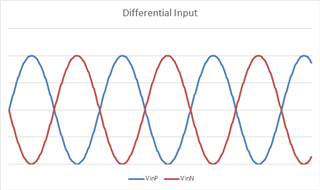Other Parts Discussed in Thread: OPA625
Hello,
can I connect single ended (0-3V) signal to the differential ADC Input by connecting this signal tu (+) input and GND (-) input without loosing dynamic range and 19-bit resolution?
Adam
This thread has been locked.
If you have a related question, please click the "Ask a related question" button in the top right corner. The newly created question will be automatically linked to this question.
Hello,
can I connect single ended (0-3V) signal to the differential ADC Input by connecting this signal tu (+) input and GND (-) input without loosing dynamic range and 19-bit resolution?
Adam
Hello Adam,
It is not possible to use the differential mode in the ADC the way you are suggesting. If you refer to Signal Mode section of the ADC chapter in the TRM (section 11.4.4), it mentions in the notes that:
"In differential signal mode, the common mode voltage is VCM = (ADCINxP + ADCINxN)/2
The datasheet for a particular device will place some requirements on how close this voltage needs to be to (VREFHI + VREFLO)/2
Note: The above condition is not met by connecting the negative input to VSSA or VREFLO."
This condition will only be met when VinP and VinN appear as below (where peak of signals is ~VREFHI and minimum of signals is ~VREFLO):

I hope this answers your question.
Best regards,
Omer Amir
Hello Adam,
I will try to confirm if this design will work for the ADC and get back to you tomorrow, but for now you can refer to the "Differential Input Model Parameters" section of the datasheet (8.10.1.2.6.1 in the document) for the recommended configuration, if you're using the F28379D device.
Best regards,
Omer Amir
Hello Adam,
I verified with another expert just to double-check, and the design for the OPA625 will not work. A fully differential input (VINP and VINM are 180deg out of phase) is required for the 16-bit differential ADC. You need to use a single-ended to fully differential output amplifier. This app note helps explain how the fully differential amps work. You can look at section 4 for an example of a single-ended to fully differential amplifier design.
Best regards,
Omer Amir